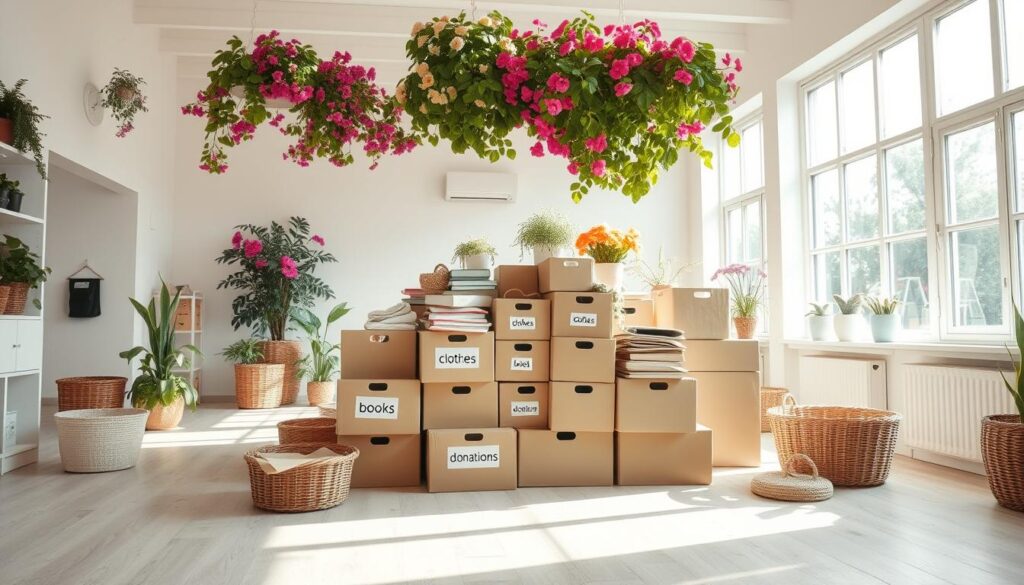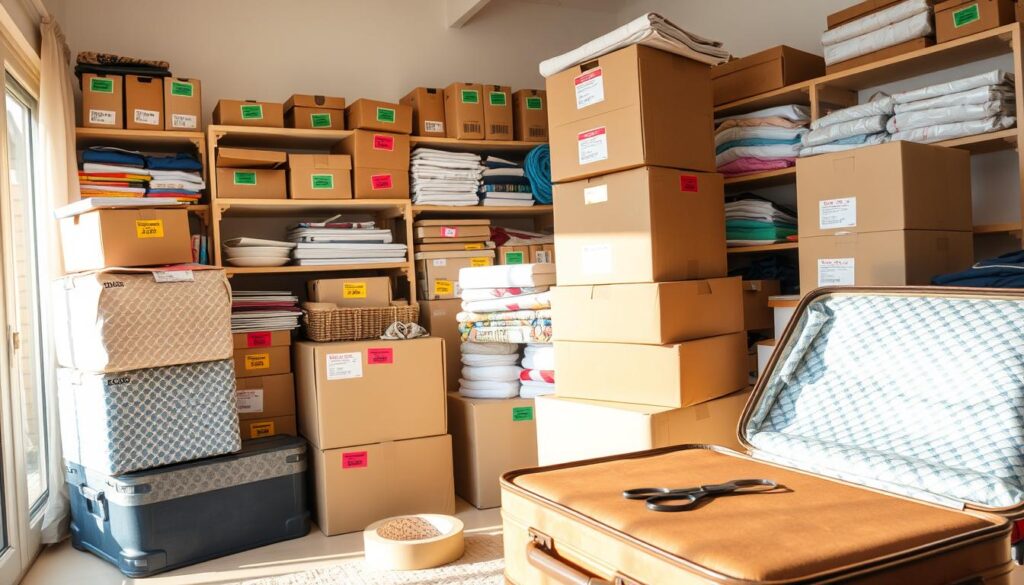Ever thought about what it means to get out of my house and start anew? Leaving your home can seem scary, but many find it leads to a life change. This guide explores the steps to vacate your residence and the mental perks of a fresh start.
Maybe you’re looking to escape financial worries or emotional baggage. Knowing why you want to exit your home is key to a better future. If you’re ready to leave quickly, Pierre Home Buyers can help. They buy homes in any state without the usual stress, covering all closing costs.
Key Takeaways
- Recognize the significance of personal motivations for change.
- Understand the importance of decluttering to facilitate a smooth move.
- Consider the financial aspects and create a budget for moving.
- Assess emotional challenges related to moving and letting go of possessions.
- Explore the role of family support during transitions.
- Plan effectively to manage the logistics of your move, including important updates.
Understanding the Need to Leave Your Home
Deciding to leave home is a big step. It requires thinking deeply about your life and why you want to change. People leave for many reasons, like wanting new experiences or to escape tough times. These reasons can make you ready for a new start.
Identifying Your Motivations for Change
Change can come from many places. Some common reasons include:
- Desire for independence and personal growth
- A need for a healthier living situation
- Coping with emotional attachments or the sense of loss associated with leaving home
- A wish to explore new environments and experiences
Knowing why you want to leave can help you make better choices. It shows how important it is to think carefully before moving.
Assessing Your Current Living Situation
Looking at your current home is key when thinking about moving. You should think about:
- Financial stability: Can you afford to relocate?
- Community ties: How do friends and family fit into your plans?
- Overall life satisfaction: Are you content or merely comfortable?
Many people feel a strong bond to their homes. This can make leaving hard, especially if you’re used to a certain place. It’s normal to feel sad about leaving behind what’s familiar.
| Current Living Situation Factors | Considerations |
|---|---|
| Financial Stability | Evaluate your budget and expenses related to housing. |
| Community Ties | Assess how your relationships and support networks might change. |
| Life Satisfaction | Reflect on your contentment and future aspirations. |
Understanding these aspects is vital when deciding to leave. Being clear about your reasons can help you move forward. Even though it might seem scary, facing these truths will help you start a new chapter.
How to Get Out of My House: Decluttering for a Fresh Start
Decluttering is more than just cleaning up. It’s a key step before moving, helping you decide what you really need. Using good strategies for sorting items makes this easier and more effective.
Sorting Your Belongings Effectively
Begin by sorting your items into categories. Ask yourself if each item is important and useful. Use keep sell donate trash zones to help decide what to do with each item.
Decluttering a little each day can be more successful than trying to do it all at once. Many people find it easier to take their time, sorting items over days or weeks.
Creating Keep, Sell, Donate, and Trash Piles
Use labeled boxes for keep sell donate trash to make decluttering easier. Many people use donation drop boxes to keep the momentum going. Setting daily or weekly goals for donations helps stay on track.
This approach not only clears space but also helps keep clutter away in the future.

The Benefits of Minimalism in Moving
Minimalism makes moving easier. With less clutter, packing is simpler and more organized. Letting go of items can also reduce stress.
Studies show that families who declutter together are more likely to keep their homes tidy. Minimalism brings clarity and simplicity, making way for a new chapter in your life.
| Method of Decluttering | Average Days to Complete | Success Rate (%) | Overwhelming Experience (%) |
|---|---|---|---|
| Gradual Decluttering | 5-14 | 75 | 20 |
| All at Once | 1-3 | 50 | 60 |
Using these strategies can change how you declutter, making your space and mind clearer. The goal is to move with clarity and purpose to your new home.
Planning for a Successful Move
Planning a move is more than picking a date. You need a solid plan to avoid last-minute problems. Start by making a detailed plan, including a timeline and budget, at least eight weeks before moving. This way, you can tackle all tasks efficiently.
Setting a Timeline and Budget
Creating a timeline and budget is key to a smooth move. A good timeline helps you stay organized and reduces stress. Start by listing important tasks like decluttering, packing, and hiring movers. Aim to plan from your moving date back to eight weeks, giving enough time for each task.
- Declutter your home—aim to eliminate about 30% of your belongings.
- Hold garage sales at least three weeks before moving for unwanted items.
- Finalize moving company arrangements within five weeks of moving.
Remember, moving costs vary based on distance and service type. For example, full-service movers might charge $1,500 to $2,500 for a three-bedroom home across country. DIY moves require packing supplies, like tape, bubble wrap, and boxes.
| Item | Estimated Cost |
|---|---|
| Packing tape | $30 |
| Bubble wrap | $50 |
| Moving boxes | $100 |
| Moving company fees | $1,500 – $2,500 |
Researching New Locations
Researching new locations is part of your preparation. Look at neighborhoods for job opportunities, cost of living, climate, and social connections. Visiting places beforehand gives you valuable insights. Looking at at least three locations helps you choose the best one.
With years of combined experience, experts have evaluated 156 moving companies. This research helps make your move smooth and successful.
Executing the Move: Logistics and Organization
Planning and organizing your move is key. You have two main choices: hiring movers or doing it yourself. Each option has its pros and cons. Also, setting up utilities and changing your address are crucial for a smooth move. Packing can be tough, but with the right tips, it can be easier.
Hiring Movers vs. DIY Moving
Choosing between hiring movers or doing it yourself depends on your situation. Movers offer a hassle-free experience with their skills and tools. Companies like Pierre Home Buyers provide move management services. On the other hand, DIY moving can save money but requires more effort and time.
Preparing Your Utilities and Address Changes
It’s important to keep your utilities running smoothly during the move. Call your providers to set up transfers or disconnections. This includes electricity, internet, gas, and water. Also, update your address with banks, insurance, and subscriptions. A checklist can help you remember everything during this busy time.
Packing Tips for an Efficient Move
Packing right is crucial for a smooth move. Here are some tips:
- Get the right supplies like boxes, tape, bubble wrap, and markers.
- Label boxes for easy unpacking.
- Make a “first-night” box with essentials like toiletries and bedding.
- Use solid moving crates for better organization and safety.

With good planning and the right tools, moving can be less stressful. From hiring movers to packing smartly, these steps help make your move successful.
Coping with the Emotional Impact of Moving
Moving can stir up a mix of emotions. It’s key to tackle these feelings well. This means dealing with the hard part of letting go and keeping relationships strong.
Letting Go of Sentimental Items
Getting ready to move can be tough, especially when it comes to sentimental items. You might want to keep everything that reminds you of good times. But, it’s okay to let go.
Try taking photos of these items before you give them up. This way, you can hold onto memories without needing to keep everything. Talking about the memories these items bring up can also help you feel connected without keeping them all.
Learning how to cope with these feelings can make a big difference. It helps you navigate the emotional side of moving better.
Maintaining Connections with Family and Friends
Keeping in touch with loved ones is vital when you move. It helps fight off loneliness and homesickness. Regular calls or video chats can offer the support you need.
Being around good friends in your new place can make you feel at home. It helps reduce stress from the move. Spend time getting to know your new area and people. Feeling familiar with your surroundings can make you feel more comfortable.
| Emotion | Recommended Strategies |
|---|---|
| Homesickness | Stay connected with loved ones through calls and social media. |
| Stress | Engage in relaxation techniques, such as meditation or yoga. |
| Anxiety | Keep a checklist to manage moving tasks effectively. |
| Loneliness | Join local groups or activities to meet new people. |
| Grief from letting go | Document memories through photography and written reflections. |
Conclusion
Learning to leave your house involves understanding your reasons, planning well, and building emotional strength. Many people think about starting anew after moving. They reflect on why they left home.
Studies show that many essays discuss what “home” means. They highlight the importance of family and hospitality in this concept.
The idea of home goes beyond owning a place. Experiences and community ties shape our sense of belonging. Discussions on cultural beliefs and land ownership show that everyone’s path to a new start is unique.
Starting anew can be tough but fulfilling. There are resources like Pierre Home Buyers for quick cash sales. By following your values and dreams, you can look forward to exciting possibilities.
For more on writing conclusions, check out this guide on conclusions.






